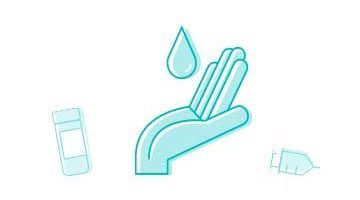Resources
Top Five Tasks Infection Preventionists Need to Prioritize in 2020
The more you plan and prepare, the safer your patients will be. Here’s advice from our clinical team members.
As the New Year begins, it’s critical for infection preventionists to begin thinking about—and preparing for—the year ahead. The more you can plan and prepare, the safer your patients will be. Here are the top five tasks (in no particular order) that our clinical team members say all infection preventionists need to prioritize over the next few months:
1. Continue monitoring re-emerging diseases such as measles and mumps.
Recent outbreaks of measles have resulted in the largest number of confirmed measles cases the U.S. has seen in 25 years, according to the CDC. Mumps is also a problem, with 48 states reporting mumps infections in 2,618 people between January 1, 2019 and October 11, 2019.
Since screening for measles and other reemerging diseases often requires specialized testing, and there can be delays in receiving positive results from off-site labs, you must have a surveillance tool in place that can assist with identifying patients that may be symptomatic, rather than waiting on the final results. That way you can respond as quickly as possible.
At APIC 2019, Jennifer Boe, BSN, RN, PHN, CIC, an infection preventionist at Children’s Minnesota, shared how she and her colleagues used VigiLanz’s clinical surveillance technology to help quell a measles outbreak in their community in 2017. “We worked with our VigiLanz support team member to create a new rule, which alerted us whenever a measles test was ordered,” said Boe. “… Knowing about suspect cases ahead of time ensured we were in the loop, and it allowed us to identify potential exposures so we could rapidly respond if the measles test was positive.”
2. Stay on top of emerging pathogens and outbreaks.
While it’s critical to monitor re-emerging diseases, it’s also important to watch for newly emerging problems. Another serious outbreak, such as Ebola, for example, could occur at any time here in the United States.
You must closely monitor your patient population for any problems and ensure you have tools in place that will flag potential problems in real time. Also, make sure you have a plan so that if a problem does arise, you can respond as quickly as possible (such as by isolating patients as soon as a test is ordered, rather than waiting for a positive result).
3. Monitor the spread of MDROs, such as Candida auris, and heighten your prevention efforts.
In 2013, the CDC estimated that 23,000 people a year die as a result of antibiotic-resistant germs; it recently nearly doubled that figure to 44,000 deaths.
We don’t need to tell you what a serious problem MDROs represents, but we can’t stress enough how critical it is to closely monitor your patient population. You must ensure you have a flexible and robust surveillance tool that can assist in the identification of at-risk, exposed, and infected patients in real time. The faster you can respond to these issues, the safer your patients will be.
4. Watch for NHSN changes impacting surveillance.
Every year, NHSN makes changes to its patient safety definitions. You can find a summary of the 2020 NHSN changes here. You must have a clinical surveillance platform that is ready to implement those changes at the start of 2020 so that the transition is seamless. At VigiLanz, we’re proud of our ability to quickly adapt and implement changes into our system based on new requirements and your healthcare system’s unique needs.
For example, at the very beginning of the New Year, we revised our CLABSI rules to account for the 12 organisms NHSN added as commensal organisms. We’re also ready to start allowing our users to report on HAI and LABID events via our file submissions. We will provide a more in-depth summary of the changes we’ve made to accommodate the 2020 updates from NHSN in our upcoming customer newsletter.
5. Improve efficiency related to identifying, documenting, and preventing risks.
Identifying potential problems related to the care environment, equipment cleaning, and sterilization, requires frequent rounding and the ability to quickly compile and disseminate your findings to stakeholders who can remediate the problems.
VigiLanz enables you to use real-time rounding tools to more efficiently document and monitor isolation compliance, hand hygiene, ICRAs, and EOCs. This ensures problems are addressed sooner, and it enables you to spend more time focusing on direct patient care.
If you already have VigiLanz in place, consider streamlining your rules so that only actionable items appear in the workflow (your clinical support team member would be happy to assist with this). Reducing the number of activations that are being created because they are nice to have, rather than needed, will reduce the time you spend working through lists.
To learn more about how to use VigiLanz to accomplish these tasks and ensure a safer 2020 for your patients, contact us today.
Unlocking Patient Safety: The Power of Autodetection in Healthcare
The key to preventing safety events and reducing harm is not about what you know is happening, but what you don’t know. Hear from Dr. Chris Emerson on how autodetection can help healthcare leaders gain visibility into the true state of patient safety inside their institutions.
Enhancing Patient Safety with Automated Event Detection: A Hospital’s Guide
Discover the benefits of autodetection, why every hospital should deploy it, and how one innovative health system is using it to enhance patient safety.
